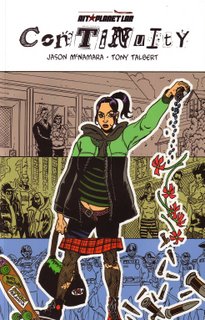Continuity
 A few months ago, Larry Young made some waves.
A few months ago, Larry Young made some waves.
This is, in itself, in no way surprising. When a wave appears, Uncle Lar's often involved in the making. We know this.
However, this particular wave was unique: an entire graphic novel being given away for free at the same time it's dead-tree version was being solicited in Previews. It was a decision that provided a spark to continuing discussion about the future of comics distribution, and certainly gathered some buzz for the title.
But what of Continuity itself? Beyond the splash of internet distribution, how does it hold up as a graphic novel, now that it's to hit stands in analog form? I personally can't cope with reading comics on a computer monitor, so I gave up on the PDF version of Continuity perhaps a quarter of the way in. So when a preview copy arrived of the print edition, I relished the chance to settle down and read it the old-fashioned way.
Distribution and marketing methods aside, Continuity is a fascinating OGN that moves a step past AiT's "HBO Of Comics" high-concept domain while still holding on to enough of that "new mainstream" energy to provide an interesting blend of the best in comics. Certainly, the "hook" is there: in a drugged-up hypercommercial dystopia, a pregnant girl tries to stay awake because she fears her dreams can change reality. It's classic Philip K. Dick material, as reality gets rewritten under your feet.
But what really makes Continuity shine is a relentless focus on the personal. The book's opening seems like we've see it before: explodo satire of American consumer culture. The genius here lies in keeping that world as setting, not as subject. The point of Continuity isn't the high-concept of a dream that rewrites reality, that's just a devious hook to explore a very complex character who's reality reflects her own fears and desires. Alicia stands at the center of her reality - as do we all - and it's her dreams and nightmares that shape the book. It reminds me of the work of one of my favorite writers, George Saunders who plays with much the same concepts of commercialism run amok to examine fragile human souls. Continuity isn't "clever" - it's messy and organic and human. It's a black and white indy comic about a tortured teen's attempts to escape her life as an outsider, almost a prototypical "art" comic. Using action and sci-fi concepts as extended metaphor, Jason McNamara and Tony Talbert have really come up with something that transcends the navel-gazing traditional "art" comics, while avoiding the shallowness that can sometimes plague the "new mainstream". It's sharp and complex, and hopefully the buzz of internet release will get some people to take notice of this little gem.

1 comment:
Downloaded it, read it, didn't like it.
The story is good and I pretty much agree with all your points. Except , it didn't engage me, as I felt it had nothing substantial or new to say.
That isn't so much of a problem if the art is good, but IMHO in this case it really isn't. The amateurish transitions in the initial action sequence are probably the worst in terms of composition, but I felt the whole book rattled in much the same way. (Which pretty much rules out authorial intent IMO). I also found lots of character depictions unclear to the point where I had to think twice who I was looking at.
Just to be sure, I re-read the Shatter preview http://isotopecomics.com/communique/shatterpdf.pdf
which IMO is similar enough in theme and style and IMO beats Continuity easily.
Post a Comment